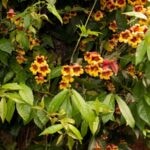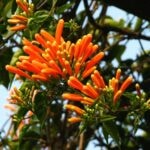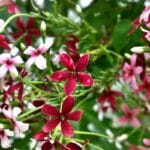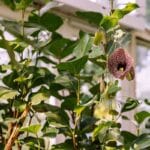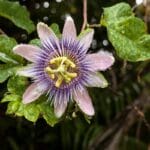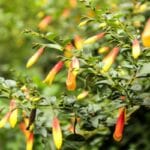One way to amp up man-made structures, such as walls and fences, is by incorporating flowering vines. It not only softens the entire look but also gives color and cohesiveness to a landscape. The coral honeysuckle vine fits perfectly for this functionality.
Read on to know how to optimize the beauty of this vine.
Botanical Information
The coral honeysuckle is famous in different locations in different names, such as trumpet honeysuckle, red honeysuckle, and woodbine. Despite the variety of common names, its scientific name Lonicera sempervirens helps clear up confusion in identifying this vine.
The genus, Lonicera, was named after a famous German botanist, Adam Lociner. Moreover, the specific epithet of the coral honeysuckle, sempervirens, translates to evergreen.
Spatial Distribution
This woody vine thrives in locations wherein the soil type is dominated by sand or clay, such as in East Texas Woodlands. Given this characteristic of favoring such an environment, this plant is recorded to be a native of East Texas, southern Maine, and Florida.
Moreover, it is vastly used in landscapes falling under USDA Zones 4 to 9.
Growth Habits
The red honeysuckle proves its versatility as a perennial woody vine as it extends from 10 to 20 feet in height and 3 to 6 feet in width. Some restrictions for this vine to become taller would be the presence of supporting structures. Its wiry reddish-brown stems efficiently twine to different structures to attract more wildlife, such as bees, butterflies, moths, and hummingbirds.
Another notable characteristic of this low maintenance plant is its bark which seems to be paper-like and easily peeled off.
Aside from being an astounding climber, this honeysuckle has proven its worth as a ground cover in different landscapes. This is made possible by its resistance to salt, compaction, black walnut, and deer.
Although it is not an aggressive grower, like Japanese honeysuckle, it still can cover enough horizontal and vertical space to make a landscape look luscious while not demanding laborious maintenance.
Leaves
The foliage of coral honeysuckle takes the shape of an oblong with a slightly pointed apex. The satin and smooth leaves are arranged oppositely and are always present throughout the year in mild warm climates.
Also, it extends from 3 to 8 cm in length. The young shoots stand out due to the presence of basally fused younger leaves.
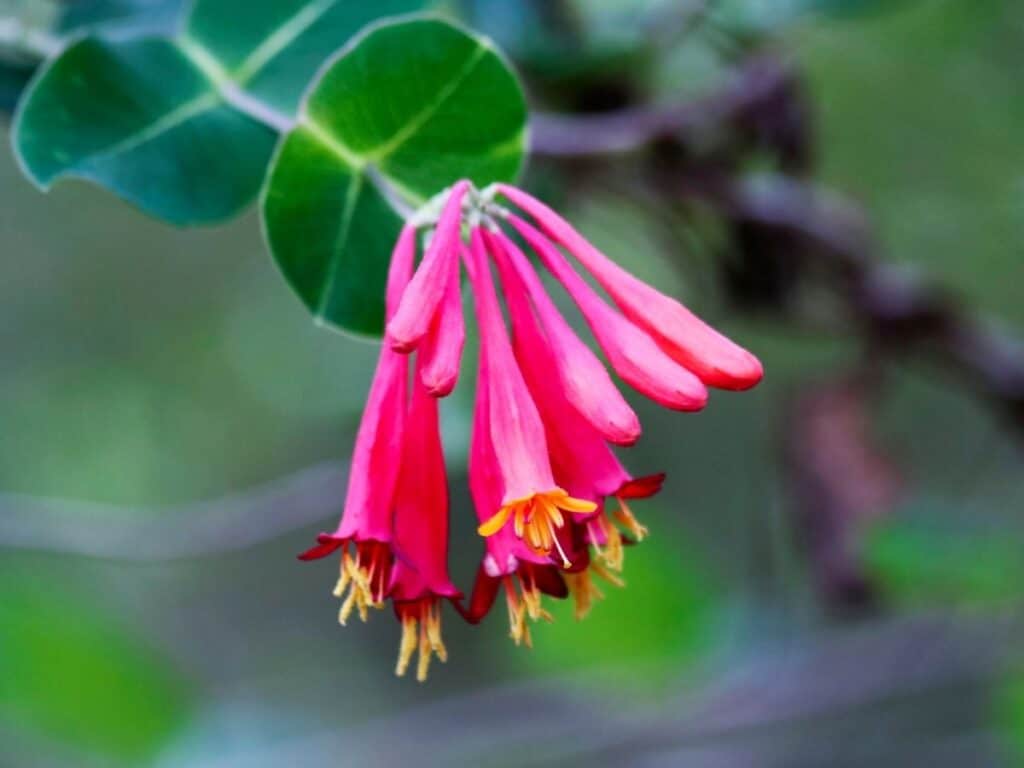
Flowers
Despite not having any scent, the flowers of coral honeysuckle are still attention-grabbing, thanks to its clustered red flowers. In each bundle, there are 2 to 5 trumpet-shaped florets with petals fused on the basal part. A good contrast to the red exterior is the bright yellow interior of the florets.
The presence of protruding anthers and stigma from the 4 upper lobes and a lower lobe makes it more noticeable. To witness the grandeur of this vine, put them in the spotlight during March through June. These pink and yellow flowers attract hummingbirds and butterflies, adding to the vibrancy of your garden.
Fruit and Seeds
After the flowering months, the coral honeysuckle will bear brightly colored red berries that are inedible. These fruits are expected a few months after the blooming months, around July to September.
How to Grow Coral Honeysuckle
Sun Requirement
This trumpet honeysuckle vine loves to be exposed under the full sunlight but can still survive under partial shade. Giving ample amounts of sun exposure to this twining vine will play a huge role in flower production.
Hence, it is important to give at least 6 hours of uninterrupted full sun to help the plant optimize its blooms.
Water Requirement
Watering requirements vary depending on factors such as climate, soil type, and sunlight exposure.
In general, newly planted coral honeysuckle should be watered regularly to establish a strong root system, typically 1-2 inches of water per week during dry periods. Once established, they are moderately drought tolerant but benefit from supplemental watering during prolonged dry spells.
It’s essential to water deeply, allowing the soil to dry slightly between waterings to prevent waterlogging and root rot.
Temperature and Humidity
As a sun-loving plant, coral honeysuckle thrives in warm and humid areas. Moreover, it also tolerates low temperatures, making it a good vine for all seasons. To ensure its health, provide good air circulation around the plant, which helps prevent fungal diseases and promotes overall vigor.
During colder winters, consider protecting the plant from frost or extreme cold by providing additional insulation or moving it to a sheltered location.
Soil Requirement
These tubular flowers will flourish in acidic soils that are rich in organic matter, good drainage, and neutral to acidic pH levels. Furthermore, giving the plant enough space to grow is also essential, with a distance of 3 to 6 feet apart.
Fertilizer Requirement
Application of complete fertilizer once or twice a year is the default practice, but this will vary depending on the soil type and the plant’s needs. For the L. sempervirens, this is also applicable with a few notes.
Application of nitrogen-rich fertilizers during the blooming period will result in the production of more foliage and fewer flowers. Hence, it should be timed properly. Furthermore, flower production will be favored if phosphorus-rich fertilizers are applied in mid spring.
Maintenance Activities
Keeping the coral honeysuckle plants in good condition does not require much maintenance. Pruning is done when needed. For example, if the vine is grown to serve as a screen and it is exceeding the borders then that is the time to prune.
Pruning is also scheduled right after flowering to keep the plant fresh and ready for new sprouts. Frequent removal of damaged and dead plant parts along with checking for pests is suggested. In doing so, a potential pest control problem could be prevented.
Propagation
Seeds are the most common way of reproduction for the coral honeysuckles as it is spread by the birds and insects. Manually, seeds are harvested when the berries are ripe, which is usually during summer or fall.
Each seed is washed, air-dried, and stored in airtight containers in rooms with 34 to 38 degrees Fahrenheit. This is done to preserve the seeds’ viability. Before sowing, seed stratification is recommended.
However, the most efficient way to propagate coral honeysuckle is by planting softwood cuttings. Choose planting materials that exhibit active new growth, but with a sturdy enough stem to support the cuttings.
Collection of such planting materials should be done during late summer to fall. To aid in the rooting process, dip the cuttings on the rooting hormone. Keep the cutting in a warm, moist, and well-drained area until it is ready for transplant.
Uses of Coral Honeysuckle
The coral honeysuckle is vastly used in landscapes with playful and interactive themes, such as butterfly gardens, pollinator gardens, natural gardens, and children’s gardens. Thanks to its growth habit, it can serve as a good addition to a horizontal or vertical space, serving as a screen, specimen, or border plant.
When incorporated with trellises and fences, annual pruning should be performed. Also, there are gardens wherein they let the vine trail down while being planted in hanging containers or green walls.
Aside from bringing color to a landscape, the L. sempervirens have some medicinal benefits. Different plant parts are harvested to be dried and smoked as a remedy for asthma. Also, the sap is applied as a topical ointment for bee stings.
Lastly, the foliage is used to create a cough syrup that is also good for sore throats. Although there are no therapeutic claims, this is commonly done in some areas wherein herbal solutions are encouraged.
Potential Harm
Aphids and leafhoppers are some of the potential pests this vine can harbor. This could easily spread throughout the landscape if not controlled properly. For aphids, washing the leaves with detergent and water is a common home remedy.
Be vigilant for signs of powdery mildew, a common fungal disease that can affect trumpet honeysuckle leaves. Regular inspection and appropriate treatment can help prevent its spread.
The application of pesticides is also an option when the pest incurs more damage to the landscape.
On the other hand, the trumpet honeysuckle also imposes potential harm by being highly flammable. The best way to avoid any fire accidents caused by this plant is by planting this vine away from flammable structures and at a good distance away from the hottest parts of the landscape.
This will come in the planning part of the landscape and is when the importance of knowing the proper orientation of the landscape is emphasized.
Lastly, despite not being an invasive species, it is still important to keep the plant trained and within its bounds. Letting it crawl all over the landscape may cause damage to the existing vegetation and disrupt the overall aesthetic of the area.
FAQs
Where is the best place to plant coral honeysuckle?
The best place to plant coral honeysuckle is in a location with well-draining soil and full to partial sunlight. It can thrive in various environments, including garden beds, borders, or along fences and trellises.
Will coral honeysuckle root in water?
Yes, Coral honeysuckle can root in water, although it may not root as readily as other plants. It’s generally recommended to propagate it using stem cuttings in soil for better success.
Is coral honeysuckle medicinal?
Yes, Coral honeysuckle (Lonicera sempervirens) has been used in traditional medicine by Native American tribes for various purposes, including treating skin conditions, sore throats, and colds. However, its medicinal properties have not been extensively studied, so caution should be exercised when using it for medicinal purposes.
Is coral honeysuckle the same as trumpet vine?
No, coral honeysuckle (Lonicera sempervirens) and trumpet vine (Campsis radicans) are not the same plant. While both are flowering vines that attract hummingbirds and other pollinators, they belong to different genera and have distinct characteristics. Coral honeysuckle typically has tubular, coral-colored flowers and twining growth habit, while trumpet vine has larger, trumpet-shaped flowers and tends to be more aggressive in its growth.
Check our blog for more vines to grow.
*image by neilld/depositphotos

